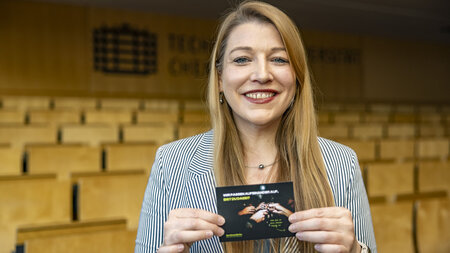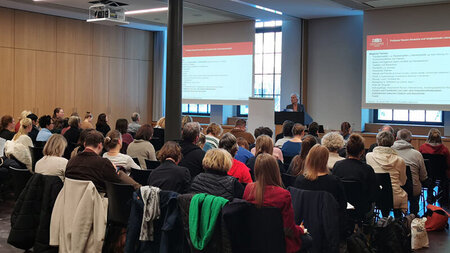Publikationen
- J - Originalarbeiten in Zeitschriften mit Begutachtungssystem/Peer Review (89)
- JO - Originalarbeiten (83)
- JR - Übersichtsarbeiten (6)
- C - begutachtete Konferenzbeiträge (13)
(Konferenzabstracts sind nicht aufgeführt) - B - Buchkapitel (6)
2025 / in press
[C.13] Bendixen, A., Wegner, T. G. G., & Einhäuser, W. (in press). Facilitating Ethics Application and Review for Interdisciplinary Human-Participant Research via Software-Based Guidance and Standardization. In B. Meyer, U. Thomas, & O. Kanoun (Eds.), Hybrid Societies - Humans Interacting with Embodied Technologies (Vol. 1). Springer.
[C.12] Kuschnereit, A., Bendixen, A., Mandl, D., & Einhäuser, W. (in press). Using Eye Tracking to Aid the Design of Human Machine Interfaces (HMIs) in Industrial Applications. In B. Meyer, U. Thomas, & O. Kanoun (Eds.), Hybrid Societies - Humans Interacting with Embodied Technologies (Vol. 1). Springer.
[JO.83] Müller, C., Bendixen, A., & Kopiske, K. (2025). Sensorimotor adaptation impedes perturbation detection in grasping. Psychonomic Bulletin & Review, 32, 373-386. https://doi.org/10.3758/s13423-024-02543-y [Open Access, Open Data, auch als Preprint verfügbar]
[JO.82] Müller, C., & Kopiske, K. (2025). Perceiving inter-leg speed differences while walking on a split-belt treadmill. Scientific Reports, 15, Article 1375. https://doi.org/10.1038/s41598-024-85091-8 [Open Access, Open Data, auch als Preprint verfügbar]
[JO.81] Pfalz, L., Müller, C., & Kopiske, K. (2025). Can pupillometry reveal perturbation detection in sensorimotor adaptation during grasping? Journal of Neurophysiology, 134, 1804-1817. https://doi.org/10.1152/jn.00259.2025 [Open Data, auch als Preprint verfügbar]
2024
[B.6] Bendixen, A., & Schröger, E. (2024). Auditive Informationsverarbeitung. In M. Rieger & J. Müsseler (Eds.), Allgemeine Psychologie (4. Aufl., pp. 59-85). Berlin: Springer. [Neuauflage zu B.4]
[JO.80] Coy, N., Bendixen, A., Grimm, S., Roeber, U., & Schröger, E. (2024). Conditional deviant repetition in the oddball paradigm modulates processing at the level of P3a but not MMN. Psychophysiology, 61(6), Article e14545. https://doi.org/10.1111/psyp.14545 [Open Access, Open Data]
[JO.79] Einhäuser, W., Neubert, C. R., Grimm, S., & Bendixen, A. (2024). High visual salience of alert signals can lead to a counterintuitive increase of reaction times. Scientific Reports, 14, Article 8858. https://doi.org/10.1038/s41598-024-58953-4 [Open Access, Open Data]
[JO.78] Feder, S., Püschel, A., Şimşek, M., Odenwald, S., Bendixen, A., & Einhäuser, W. (2024). Visual Search for Hazardous Items: Using Virtual Reality (VR) in Laypersons to Test Wearable Displays for Firefighters. Frontiers in Virtual Reality, 5, Article 1252351. https://doi.org/10.3389/frvir.2024.1252351 [Open Access, Open Material, auch als Preprint verfügbar]
[JO.77] Grenzebach, J., Wegner, T. G. G., Einhäuser, W., & Bendixen, A. (2024). Bimodal moment-by-moment coupling in perceptual multistability. Journal of Vision, 24(5), Article 16. https://doi.org/10.1167/jov.24.5.16 [Open Access, Open Data]
[JO.76] Magerle, R., Zech, P., Dehnert, M., Bendixen, A., & Otto, A. (2024). Rate-independent hysteretic energy dissipation in collagen fibrils. Soft Matter, 20, 2831-2839. https://doi.org/10.1039/d3sm01625k [auch als Postprint verfügbar]
[JO.75] Walper, D., Bendixen, A., Grimm, S., Schubö, A., & Einhäuser, W. (2024). Attention deployment in natural scenes: higher-order scene statistics rather than semantics modulate the N2pc component. Journal of Vision, 24(6), Article 7. https://doi.org/10.1167/jov.24.6.7 [Open Access]
2023
[JO.74] Coy, N., Bendixen, A., Grimm, S., Roeber, U., & Schröger, E. (2023). Deviants violating higher-order auditory regularities can become predictive and facilitate behaviour. Attention, Perception, & Psychophysics, 85(8), 2731-2750. https://doi.org/10.3758/s13414-023-02763-9 [Open Access, Open Data]
[C.11] Eisenträger, K., Haubner, J., Brade, J., Einhäuser, W., Bendixen, A., Winkler, S, Klimant, P., & Jahn, G. (2023). Evaluating the Effects of Virtual‐Reality Environment Learning on Subsequent Robot Teleoperation in an Unfamiliar Building. IEEE Transactions on Visualization and Computer Graphics, 29, 2220-2229. https://doi.org/10.1109/TVCG.2023.3247052
[JO.73] Feder, S., Miksch, J., Grimm, S., Krems, J. F., & Bendixen, A. (2023). Using event-related brain potentials to evaluate motor-auditory latencies in virtual reality. Frontiers in Neuroergonomics, 4, Article 1196507. https://doi.org/10.3389/fnrgo.2023.1196507 [Open Access, Open Data, auch als Preprint verfügbar]
[JO.72] Ivanova, M., Neubert, C. R., Schmied, J., & Bendixen, A. (2023). ERP evidence for Slavic and German word stress cue sensitivity in English. Frontiers in Psychology, 14, Article 1193822. https://doi.org/10.3389/fpsyg.2023.1193822 [Open Access, Open Data, auch als Preprint verfügbar]
[JO.71] Kopiske, K., Heinrich, E.-M., Jahn, G., Bendixen, A., & Einhäuser, W. (2023). Multisensory cues for walking in virtual reality: Humans combine conflicting visual and self-motion information to reproduce distances. Journal of Neurophysiology, 130(4), 1028-1040. https://journals.physiology.org/doi/abs/10.1152/jn.00011.2023 [Open Data]
[JO.70] Müller, C., Baumann, T., Einhäuser, W., & Kopiske, K. (2023). Slipping while counting - gaze-gait interactions during perturbed walking under dual-task conditions. Experimental Brain Research, 241, 765-780. https://doi.org/10.1007/s00221-023-06560-6 [Open Access, Open Data, auch als Preprint verfügbar]
[B.5] Schröger, E., & Bendixen, A. (2023). Auditory Processing. In G.J. Boyle, G. Northoff, A.K. Barbey, F. Fregni, M. Jahanshahi, Á. Pascual-Leone, & B.J. Sahakian (Eds.), The Sage Handbook of Cognitive and Systems Neuroscience (pp. 337-350). Sage.
2022
[C.10] Bosch, E., Klosterkamp, M., Guevara, A., Käthner, D., Bendixen, A., & Ihme, K. (2022). Multimodal Estimation of Frustrative Driving Situations Using a Latent Variable Model. In 2022 IEEE 13th International Conference on Cognitive InfoCommunications (CogInfoCom) (pp. 000011-000016). https://doi.org/10.1109/CogInfoCom55841.2022.10081636
[C.9] Breitkreutz, C., Brade, J., Winkler, S., Bendixen, A., Klimant, P., & Jahn, G. (2022). Spatial Updating in Virtual Reality - Auditory and Visual Cues in a Cave Automatic Virtual Environment. In 2022 IEEE Conference on Virtual Reality and 3D User Interfaces (VR) (pp. 719-727). https://doi.org/10.1109/VR51125.2022.00093
[JO.69] Coy, N., Bendixen, A., Grimm, S., Roeber, U., & Schröger, E. (2022). Is the oddball just an odd-one-out? The predictive value of rule-violating events. Auditory Perception & Cognition, 5(3-4), 169-191. https://doi.org/10.1080/25742442.2022.2094657 [Open Access, Open Data]
[C.8] Feder, S., Bendixen, A., & Einhäuser, W. (2022). A hybrid control strategy for capturing cognitive processes in virtual reality (VR) in a natural and efficient way. In 2022 IEEE 9th International Conference on Computational Intelligence and Virtual Environments for Measurement Systems and Applications (CIVEMSA) (pp. 1-6). https://doi.org/10.1109/CIVEMSA53371.2022.9853646
[JO.68] Thomassen, S., Hartung, K., Einhäuser, W., & Bendixen, A. (2022). Low-high-low or high-low-high? Pattern effects on sequential auditory scene analysis. Journal of the Acoustical Society of America, 152(5), 2758-2768. https://doi.org/10.1121/10.0015054 [Open Data]
2021
[JO.67] Drewes, J., Feder, S., & Einhäuser, W. (2021). Gaze during locomotion in virtual reality and the real world. Frontiers in Neuroscience, 15, Article 656913. https://doi.org/10.3389/fnins.2021.656913 [Open Access, Video 1, Video 2]
[JO.66] Grenzebach, J., Wegner, T. G. G., Einhäuser, W., & Bendixen, A. (2021). Pupillometry in auditory multistability. PLOS ONE, 16, Article e0252370. https://doi.org/10.1371/journal.pone.0252370 [Open Access, Open Data]
[JO.65] Kopiske, K., Koska, D., Baumann, T., Maiwald, C., & Einhäuser, W. (2021). Icy road ahead - rapid adjustments of gaze-gait interactions during perturbed naturalistic walking. Journal of Vision, 21(8), Article 11. https://doi.org/10.1167/jov.21.8.11 [Open Access, Open Data]
[JO.64] Neubert, C. R., Förstel, A. P., Debener, S., & Bendixen, A. (2021). Predictability-based source segregation and sensory deviance detection in auditory aging. Frontiers in Human Neuroscience, 15, Article 734231. https://doi.org/10.3389/fnhum.2021.734231 [Open Access]
[JO.63] Wegner, T. G. G., Grenzebach, J., Bendixen, A., & Einhäuser, W. (2021). Parameter dependence in visual pattern-component rivalry at onset and during prolonged viewing. Vision Research, 182, 69-88. https://doi.org/10.1016/j.visres.2020.12.006
2020
[JO.62] Einhäuser, W., da Silva, L. F. O., & Bendixen, A. (2020). Intraindividual consistency between auditory and visual multistability. Perception, 49, 119-138. https://doi.org/10.1177/0301006619896282 [Open Data]
2019
[C.7] Bendixen, A. (2019). The object-related negativity (ORN) component as an objective measure of concurrent sound segregation. In M. Ochmann, M. Vorländer, & J. Fels (Eds.), Proceedings of the 23rd International Congress on Acoustics (pp. 5651-5658). Berlin: DEGA. https://doi.org/10.18154/RWTH-CONV-239689 [Open Access]
[JO.61] Kopiske, K. K.*, Bozzacchi, C.*, Volcic, R., & Domini, F. (2019). Multiple distance cues do not prevent systematic biases in reach to grasp movements. Psychological Research, 83, 147-158. https://doi.org/10.1007/s00426-018-1101-9 *contributed equally [Open Access]
[JO.60] Stuckenberg, M. V., Nayak, C. V., Meyer, B. T., Völker, C., Hohmann, V., & Bendixen, A. (2019). Age effects on concurrent speech segregation by onset asynchrony. Journal of Speech, Language, and Hearing Research, 62, 177-189. https://doi.org/10.1044/2018_JSLHR-H-18-0064
[C.6] Thomassen, S., & Bendixen, A. (2019). Foreground-background decomposition in complex auditory scenes. In M. Ochmann, M. Vorländer, & J. Fels (Eds.), Proceedings of the 23rd International Congress on Acoustics (pp. 5685-5691). Berlin: DEGA. https://doi.org/10.18154/RWTH-CONV-239397 [Open Access]
2018
[JO.59] Gandras, K., Grimm, S., & Bendixen, A. (2018). Electrophysiological correlates of speaker segregation and foreground-background selection in ambiguous listening situations. Neuroscience, 389, 19-29. https://doi.org/10.1016/j.neuroscience.2017.07.021
[JO.58] Kopiske, K. K., & Franz, V. H. (2018). Comparing symbolic and nonsymbolic number lines: Consistent effects of notation across output measures. Advances in Cognitive Psychology, 14, 87-100. https://doi.org/10.5709/acp-0241-9
[JO.57] Kopiske, K. K., & Domini, F. (2018). On the response function and range dependence of manual estimation. Experimental Brain Research, 236, 1309-1320. https://doi.org/10.1007/s00221-018-5223-5 [Open Access, Open Data]
[JO.56] Thomassen, S., & Bendixen, A. (2018). Assessing the background decomposition of a complex auditory scene with event-related brain potentials. Hearing Research, 370, 120-129. https://doi.org/10.1016/j.heares.2018.09.008
2017
[B.4] Bendixen, A., & Schröger, E. (2017). Auditive Informationsverarbeitung. In J. Müsseler & M. Rieger (Eds.), Allgemeine Psychologie (3. Aufl., pp. 51-73). Berlin: Springer. [Neuauflage: B.6]
[JO.55] Einhäuser, W., Methfessel, P., & Bendixen, A. (2017). Newly acquired audio-visual associations bias perception in binocular rivalry. Vision Research, 133, 121-129. https://doi.org/10.1016/j.visres.2017.02.001 [Open Data]
[JO.54] Einhäuser, W., Thomassen, S., & Bendixen, A. (2017). Using binocular rivalry to tag foreground sounds: towards an objective visual measure for auditory multistability. Journal of Vision, 17(1), Article 34. https://doi.org/10.1167/17.1.34 [Open Access, Open Data]
[JO.53] Thomassen, S., & Bendixen, A. (2017). Subjective perceptual organization of a complex auditory scene. Journal of the Acoustical Society of America, 141, 265-276. https://doi.org/10.1121/1.4973806
2016
[B.3] Bendixen, A., & Puschmann, S. (2016). Auditory system. In H. L. Miller (Ed.), The SAGE Encyclopedia of Theory in Psychology (pp. 65-66). Thousand Oaks: SAGE Publications. https://doi.org/10.4135/9781483346274.n25
[JO.52] Farkas, D., Denham, S. L., Bendixen, A., Tóth, D., Kondo, H. M., & Winkler, I. (2016). Auditory multi-stability: Idiosyncratic perceptual switching patterns, executive functions and personality traits. PLoS One, 11, Article e0154810. https://doi.org/10.1371/journal.pone.0154810 [Open Access]
[JO.51] Farkas, D., Denham, S. L., Bendixen, A., & Winkler, I. (2016). Assessing the validity of subjective reports in the auditory streaming paradigm. Journal of the Acoustical Society of America, 139, 1762-1772. https://doi.org/10.1121/1.4945720
[JO.50] Kocsis, Z., Winkler, I., Bendixen, A., & Alain, C. (2016). Promoting the perception of two and three concurrent sound objects: An event-related potential study. International Journal of Psychophysiology, 107, 16-28. https://doi.org/10.1016/j.ijpsycho.2016.06.016
[JO.49] Scharinger, M., Bendixen, A., Herrmann, B., Henry, M.J., Mildner, T., & Obleser, J. (2016). Predictions interact with missing sensory evidence in semantic processing areas. Human Brain Mapping, 37, 704-716. https://doi.org/10.1002/hbm.23060
2015
[JO.48] Bauer, A.-K. R., Jaeger, M., Thorne, J. D., Bendixen, A., & Debener, S. (2015). The auditory dynamic attending theory revisited: A closer look at the pitch comparison task. Brain Research, 1626, 198-210. https://doi.org/10.1016/j.brainres.2015.04.032
[JO.47] Bendixen, A., Duwe, S., & Reiche, M. (2015). Noise occlusion in discrete tone sequences as a tool towards auditory predictive processing? Brain Research, 1626, 97-107. https://doi.org/10.1016/j.brainres.2015.06.045
[JO.46] Bendixen, A., Háden, G. P., Németh, R., Farkas, D., Tőrők, M., & Winkler, I. (2015). Newborn infants detect cues of concurrent sound segregation. Developmental Neuroscience, 37, 172-181. https://doi.org/10.1159/000370237
[JO.45] Bendixen, A., Schwartze, M., & Kotz, S. A. (2015). Temporal dynamics of contingency extraction from tonal and verbal auditory sequences. Brain and Language, 148, 64-73. https://doi.org/10.1016/j.bandl.2014.11.009
[JO.44] Cornella, M., Bendixen, A., Grimm, S., Leung, S., Schröger, E., & Escera, C. (2015). Spatial auditory regularity encoding and prediction: human middle-latency and long-latency auditory evoked potentials. Brain Research, 1626, 21-30. https://doi.org/10.1016/j.brainres.2015.04.018
[C.5] Widmann, A., Bendixen, A., Wetzel, N., Duwe, S., Engbert, R., & Schröger, E. (2015). Untersuchung der Chronometrie auditiver kognitiver Prozesse mittels Augenbewegungen. In S. Becker (Ed.), Fortschritte der Akustik - DAGA 2015 (S. 1224-1226). Berlin: DEGA.
2014
[JR.6] Bendixen, A. (2014). Predictability effects in auditory scene analysis: A review. Frontiers in Neuroscience, 8, Article 60. https://doi.org/10.3389/fnins.2014.00060 [Open Access]
[JO.43] Bendixen, A., Denham, S. L., & Winkler, I. (2014). Feature predictability flexibly supports auditory stream segregation or integration. Acta Acustica united with Acustica, 100, 888-899. https://doi.org/10.3813/AAA.918768
[JR.5] Bendixen, A., & Koch, I. (2014). Auditory attention: Merging paradigms and perspectives. Special Issue Editorial. Psychological Research, 78, 301-303. https://doi.org/10.1007/s00426-014-0562-8
[JO.42] Bendixen, A., Scharinger, M., Strauß, A., & Obleser, J. (2014). Prediction in the service of comprehension: Modulated early brain responses to omitted speech segments. Cortex, 53, 9-26. https://doi.org/10.1016/j.cortex.2014.01.001
[JO.41] Denham, S. L., Bőhm, T. M., Bendixen, A., Szalárdy, O., Kocsis, Z., Mill, R., & Winkler, I. (2014). Stable individual characteristics in the perception of multiple embedded patterns in multistable auditory stimuli. Frontiers in Neuroscience, 8, Article 25. https://doi.org/10.3389/fnins.2014.00025 [Open Access]
[JO.40] Kocsis, Z., Winkler, I., Szalárdy, O., & Bendixen, A. (2014). Effects of multiple congruent cues on concurrent sound segregation during passive and active listening: An event-related potential (ERP) study. Biological Psychology, 100, 20-33. https://doi.org/10.1016/j.biopsycho.2014.04.005
[JR.4] Malmierca, M. S., Sanchez-Vives, M. V., Escera, C., & Bendixen, A. (2014). Neuronal adaptation, novelty detection and regularity encoding in audition. Frontiers in Systems Neuroscience, 8, Article 111. https://doi.org/10.3389/fnsys.2014.00111 [Open Access]
[JO.39] Puschmann, S., Sandmann, P., Bendixen, A., & Thiel, C. M. (2014). Age-related hearing loss increases crossmodal distractibility. Hearing Research, 316, 28-36. https://doi.org/10.1016/j.heares.2014.07.005
[JR.3] Schröger, E., Bendixen, A., Denham, S. L., Mill, R., Bőhm, T. M., & Winkler, I. (2014). Predictive regularity representations in violation detection and auditory stream segregation: From conceptual to computational models. Brain Topography, 27, 565-577. https://doi.org/10.1007/s10548-013-0334-6
[JO.38] Shestopalova, L. B., Bőhm, T. M., Bendixen, A., Andreou, A. G., Georgiou, J., Garreau, G., Hajdu, B., Denham, S. L., & Winkler, I. (2014). Do audio-visual motion cues promote segregation of auditory streams? Frontiers in Neuroscience, 8, Article 64. https://doi.org/10.3389/fnins.2014.00064 [Open Access]
[JO.37] Spielmann, M. I., Schröger, E., Kotz, S. A., & Bendixen, A. (2014). Attention effects on auditory scene analysis: Insights from event-related brain potentials. Psychological Research, 78, 361-378. https://doi.org/10.1007/s00426-014-0547-7
[JO.36] Szalárdy, O., Bendixen, A., Bőhm, T. M., Davies, L. A., Denham, S. L., & Winkler, I. (2014). The effects of rhythm and melody on auditory stream segregation. Journal of the Acoustical Society of America, 135, 1392-1405. https://doi.org/10.1121/1.4865196
[JO.35] Tavano, A., Widmann, A., Bendixen, A., Trujillo-Barreto, N. J., & Schröger, E. (2014). Temporal regularity facilitates higher-order sensory predictions in fast auditory sequences. European Journal of Neuroscience, 39, 308-318. https://doi.org/10.1111/ejn.12404
2013
[JO.34] Bendixen, A., & Andersen, S. K. (2013). Measuring target detection performance in paradigms with high event rates. Clinical Neurophysiology, 124, 928-940. https://doi.org/10.1016/j.clinph.2012.11.012
[JO.33] Bendixen, A., Bőhm, T. M., Szalárdy, O., Mill, R., Denham, S. L., & Winkler, I. (2013). Different roles of similarity and predictability in auditory stream segregation. Learning and Perception, 5, 37-54. https://doi.org/10.1556/LP.5.2013.Suppl2.4
[C.4] Bendixen, A., Denham, S. L., & Winkler, I. (2013). Sound predictability as a higher-order cue in auditory scene analysis. In AIA-DAGA 2013, International Conference on Acoustics (pp. 705-708). Berlin: DEGA.
[JO.32] Bőhm, T. M., Shestopalova, L., Bendixen, A., Andreou, A. G., Georgiou, J., Garreau, G., Pouliquen, P., Cassidy, A., Denham, S. L., & Winkler, I. (2013). The role of perceived source location in auditory stream segregation: Separation affects sound organization, common fate does not. Learning and Perception, 5, 55-72. https://doi.org/10.1556/LP.5.2013.Suppl2.5
[JO.31] Mill, R. W., Bőhm, T. M., Bendixen, A., Winkler, I., & Denham, S. L. (2013). Modelling the emergence and dynamics of perceptual organisation in auditory streaming. PLoS Computational Biology, 9, Article e1002925. https://doi.org/10.1371/journal.pcbi.1002925 [Open Access, Open Material]
[JO.30] Reiche, M., Hartwigsen, G., Widmann, A., Saur, D., Schröger, E., & Bendixen, A. (2013). Involuntary attentional capture by speech and non-speech deviations: A combined behavioral - event-related potential study. Brain Research, 1490, 153-160. https://doi.org/10.1016/j.brainres.2012.10.055
[JO.29] SanMiguel, I., Widmann, A., Bendixen, A., Trujillo-Barreto, N., & Schröger, E. (2013). Hearing silences: Human auditory processing relies on pre-activation of sound-specific brain activity patterns. Journal of Neuroscience, 33, 8633-8639. https://doi.org/10.1523/JNEUROSCI.5821-12.2013
[B.2] Schröger, E., SanMiguel, I., & Bendixen, A. (2013). Prädiktive Modellierung in der auditiven Wahrnehmung. In E. Schröger & S. Koelsch (Eds.), Affektive und Kognitive Neurowissenschaft. Enzyklopädie der Psychologie (Serie II: Kognition, Band 5) (pp. 11-45). Göttingen: Hogrefe.
[JO.28] Spielmann, M. I., Schröger, E., Kotz, S. A., Pechmann, T., & Bendixen, A. (2013). Using a staircase procedure for the objective measurement of auditory stream integration and segregation thresholds. Frontiers in Psychology, 4, Article 534. https://doi.org/10.3389/fpsyg.2013.00534 [Open Access]
[JO.27] Szalárdy, O., Bendixen, A., Tóth, D., Denham, S. L., & Winkler, I. (2013). Modulation frequency acts as a primary cue for auditory stream segregation. Learning and Perception, 5, 149-161. https://doi.org/10.1556/LP.5.2013.Suppl2.9
[JO.26] Szalárdy, O., Bőhm, T. M., Bendixen, A., & Winkler, I. (2013). Event-related potential correlates of sound organization: early sensory and late cognitive effects. Biological Psychology, 93, 97-104. https://doi.org/10.1016/j.biopsycho.2013.01.015
[JO.25] Szalárdy, O., Winkler, I., Schröger, E., Widmann, A., & Bendixen, A. (2013). Foreground-background discrimination indicated by event-related brain potentials in a new auditory multistability paradigm. Psychophysiology, 50, 1239-1250. https://doi.org/10.1111/psyp.12139
2012
[JR.2] Bendixen, A., SanMiguel, I., & Schröger, E. (2012). Early electrophysiological indicators for predictive processing in audition: A review. International Journal of Psychophysiology, 83, 120-131. https://doi.org/10.1016/j.ijpsycho.2011.08.003
[JO.24] Bendixen, A., Schröger, E., Ritter, W., & Winkler, I. (2012). Regularity extraction from non-adjacent sounds. Frontiers in Psychology, 3, Article 143. https://doi.org/10.3389/fpsyg.2012.00143 [Open Access]
[JO.23] Denham, S. L., Bendixen, A., Mill, R., Tóth, D., Wennekers, T., Coath, M., Bőhm, T. M., Szalárdy, O., & Winkler, I. (2012). Characterising switching behaviour in perceptual multi-stability. Journal of Neuroscience Methods, 210, 79-92. https://doi.org/10.1016/j.jneumeth.2012.04.004
[JO.22] Horváth, J., & Bendixen, A. (2012). Preventing distraction by probabilistic cueing. International Journal of Psychophysiology, 83, 342-347. https://doi.org/10.1016/j.ijpsycho.2011.11.019
[JO.21] Rimmele, J. M., Schröger, E., & Bendixen, A. (2012). Age-related changes in the use of regular patterns for auditory scene analysis. Hearing Research, 289, 98-107. https://doi.org/10.1016/j.heares.2012.04.006
[JO.20] Scharinger, M., Bendixen, A., Trujillo-Barreto, N. J., & Obleser, J. (2012). A sparse neural code for some speech sounds but not for others. PLoS One, 7, Article e40953. https://doi.org/10.1371/journal.pone.0040953 [Open Access]
[JO.19] Weise, A., Bendixen, A., Müller, D., & Schröger, E. (2012). Which kind of transition is important for sound representation? An event-related potential study. Brain Research, 1464, 30-42. https://doi.org/10.1016/j.brainres.2012.04.046
[JO.18] Weise, A., Schröger, E., & Bendixen, A. (2012). The processing of concurrent sounds based on inharmonicity and asynchronous onsets: An object-related negativity (ORN) study. Brain Research, 1439, 73-81. https://doi.org/10.1016/j.brainres.2011.12.044
[JR.1] Winkler, I., Denham, S. L., Mill, R., Bőhm, T. M., & Bendixen, A. (2012). Multistability in auditory stream segregation: A predictive coding view. Philosophical Transactions of the Royal Society of London. Series B: Biological Sciences, 367, 1001-1012. https://doi.org/10.1098/rstb.2011.0359
[C.3] Winkler, I., Böhm, T. M., Mill, R. W., Bendixen, A., & Denham, S. L. (2012). Modelling auditory stream segregation by predictive processes. In 3rd International Conference on Cognitive Infocommunications (CogInfoCom) (pp. 479-483). Košice, Slovakia: IEEE. https://doi.org/10.1109/CogInfoCom.2012.6422029
2011
[C.2] Georgiou, J., Pouliquen, P., Cassidy, A., Garreau, G., Andreou, C., Stuarts, G., d'Urbal, C., Andreou, A. G., Denham, S. L., Wennekers, T., Mill, R., Winkler, I., Böhm, T. M., Szalárdy, O., Klump, G. M., Jones, S. J., & Bendixen, A. (2011). A multimodal-corpus data collection system for cognitive acoustic scene analysis. In 45th Annual Conference on Information Sciences and Systems (CISS) (pp. 37-42). Baltimore, USA: IEEE. https://doi.org/10.1109/CISS.2011.5766101
[C.1] Mill, R., Böhm, T. M., Bendixen, A., Winkler, I., & Denham, S. L. (2011). CHAINS: Competition and cooperation between fragmentary event predictors in a model of auditory scene analysis. In 45th Annual Conference on Information Sciences and Systems (CISS) (pp. 1-6). Baltimore, USA: IEEE. https://doi.org/10.1109/CISS.2011.5766095
2010
[B.1] Bendixen, A. (2010). Using electrophysiology to study unconscious memory representations. In I. Winkler & I. Czigler (Eds.), Unconscious memory representations in perception: Processes and mechanisms in the brain (pp. 259-271). Amsterdam: John Benjamins.
[JO.17] Bendixen, A., Denham, S. L., Gyimesi, K., & Winkler, I. (2010). Regular patterns stabilize auditory streams. Journal of the Acoustical Society of America, 128, 3658-3666. https://doi.org/10.1121/1.3500695
[JO.16] Bendixen, A., Grimm, S., Deouell, L. Y., Wetzel, N., Mädebach, A., & Schröger, E. (2010). The time-course of auditory and visual distraction effects in a new crossmodal paradigm. Neuropsychologia, 48, 2130-2139. https://doi.org/10.1016/j.neuropsychologia.2010.04.004
[JO.15] Bendixen, A., Jones, S. J., Klump, G., & Winkler, I. (2010). Probability dependence and functional separation of the object-related and mismatch negativity event-related potential components. Neuroimage, 50, 285-290. https://doi.org/10.1016/j.neuroimage.2009.12.037
[JO.14] Bubic, A., Bendixen, A., Schubotz, R. I., Jacobsen, T., & Schröger, E. (2010). Differences in processing violations of sequential and feature regularities as revealed by visual event-related brain potentials. Brain Research, 1317, 192-202. https://doi.org/10.1016/j.brainres.2009.12.072
[JO.13] Sandmann, P., Kegel, A., Eichele, T., Dillier, N., Lai, W., Bendixen, A., Debener, S., Jäncke, L., & Meyer, M. (2010). Neurophysiological evidence of impaired musical sound perception in cochlear-implant users. Clinical Neurophysiology, 121, 2070-2082. https://doi.org/10.1016/j.clinph.2010.04.032
2009
[JO.12] Bendixen, A., Schröger, E., & Winkler, I. (2009). I heard that coming: event-related potential evidence for stimulus-driven prediction in the auditory system. Journal of Neuroscience, 29, 8447-8451. https://doi.org/10.1523/JNEUROSCI.1493-09.2009
[JO.11] Grimm, S., Bendixen, A., Deouell, L. Y., & Schröger, E. (2009). Distraction in a visual multi-deviant paradigm: behavioral and event-related potential effects. International Journal of Psychophysiology, 72, 260-266. https://doi.org/10.1016/j.ijpsycho.2009.01.005
[JO.10] Saupe, K., Widmann, A., Bendixen, A., Müller, M. M., & Schröger, E. (2009). Effects of intermodal attention on the auditory steady-state response and the event-related potential. Psychophysiology, 46, 321-327. https://doi.org/10.1111/j.1469-8986.2008.00765.x
2008
[JO.9] Bendixen, A., Prinz, W., Horváth, J., Trujillo-Barreto, N. J., & Schröger, E. (2008). Rapid extraction of auditory feature contingencies. Neuroimage, 41, 1111-1119. https://doi.org/10.1016/j.neuroimage.2008.03.040
[JO.8] Bendixen, A., & Schröger, E. (2008). Memory trace formation for abstract auditory features and its consequences in different attentional contexts. Biological Psychology, 78, 231-241. https://doi.org/10.1016/j.biopsycho.2008.03.005
[JO.7] Grimm, S., Schröger, E., Bendixen, A., Bäß, P., Roye, A., & Deouell, L. Y. (2008). Optimizing the auditory distraction paradigm: Behavioral and event-related potential effects in a lateralized multi-deviant approach. Clinical Neurophysiology, 119, 934-947. https://doi.org/10.1016/j.clinph.2007.12.011
[JO.6] Horváth, J., Roeber, U., Bendixen, A., & Schröger, E. (2008). Specific or general? The nature of attention set changes triggered by distracting auditory events. Brain Research, 1229, 193-203. https://doi.org/10.1016/j.brainres.2008.06.096
[JO.5] Horváth, J., Winkler, I., & Bendixen, A. (2008). Do N1/MMN, P3a, and RON form a strongly coupled chain reflecting the three stages of auditory distraction? Biological Psychology, 79, 139-147. https://doi.org/10.1016/j.biopsycho.2008.04.001
2007
[JO.4] Bendixen, A., Roeber, U., & Schröger, E. (2007). Regularity extraction and application in dynamic auditory stimulus sequences. Journal of Cognitive Neuroscience, 19, 1664-1677. https://doi.org/10.1162/jocn.2007.19.10.1664
[JO.3] Schröger, E., Bendixen, A., Trujillo-Barreto, N. J., & Roeber, U. (2007). Processing of abstract rule violations in audition. PLoS One, 2, Article e1131. https://doi.org/10.1371/journal.pone.0001131 [Open Access]
2006
[JO.2] Bendixen, A., Grimm, S., & Schröger, E. (2006). The relation between onset, offset, and duration perception as examined by psychophysical data and event-related brain potentials. Journal of Psychophysiology, 20, 40-51. https://doi.org/10.1027/0269-8803.20.1.40
2005
[JO.1] Bendixen, A., Grimm, S., & Schröger, E. (2005). Human auditory event-related potentials predict duration judgments. Neuroscience Letters, 383, 284-288. https://doi.org/10.1016/j.neulet.2005.04.034





